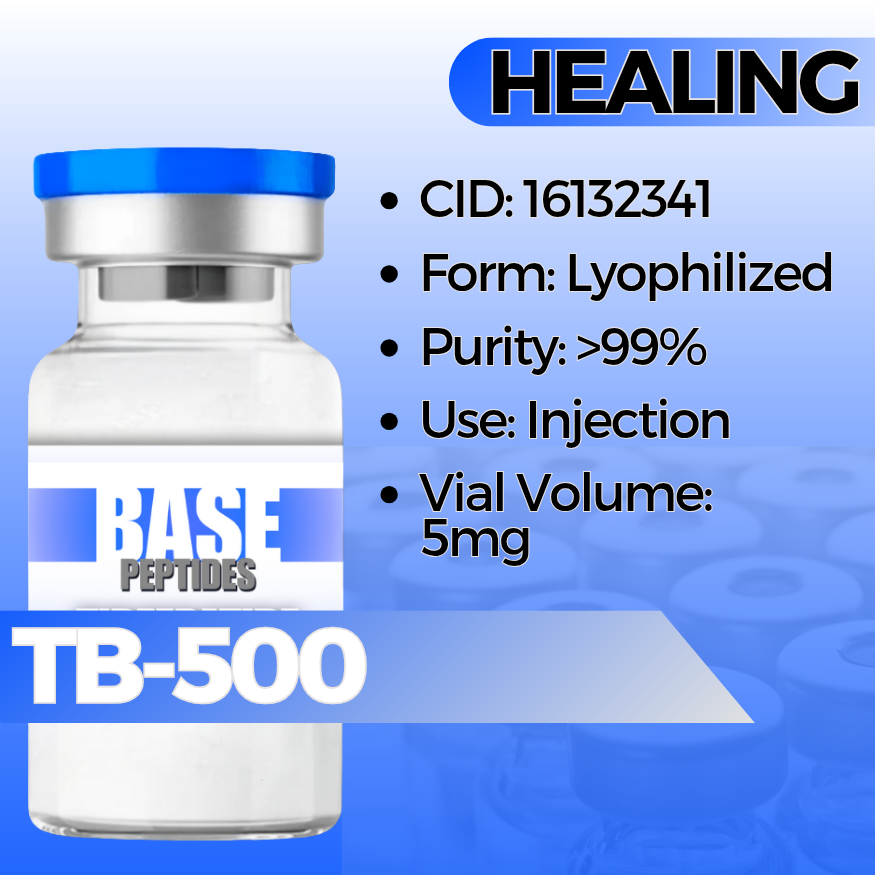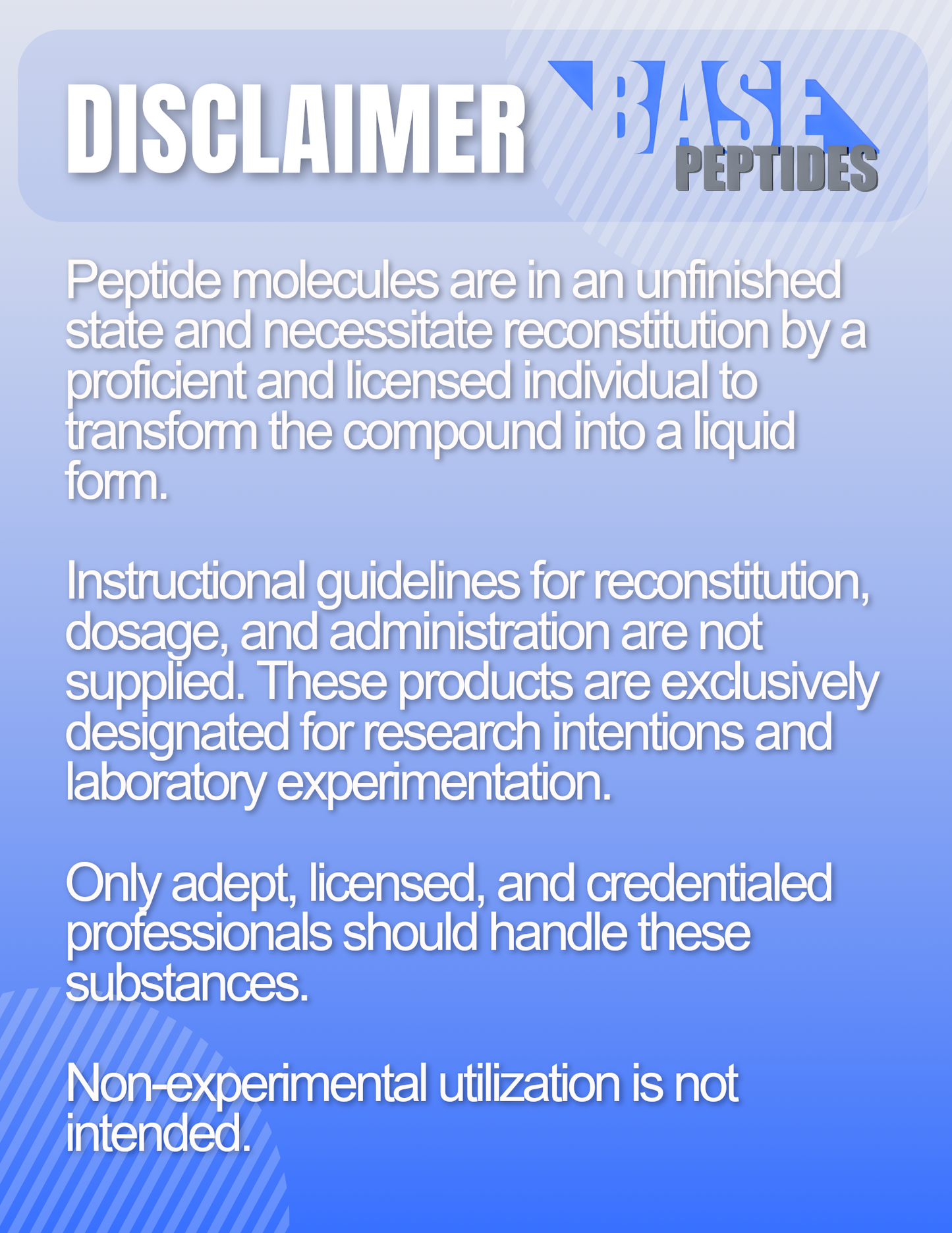TB-500
TB-500
Base Peptides are intended for licensed medical professionals and experienced researchers. Reconstitution required. Dosing and use instructions are not provided.
Couldn't load pickup availability
TB-500 — Thymosin-β4 Active-Site Fragment (LKKTETQ)
TB-500 is a synthetic peptide modeled on the short active site within thymosin-β4 (Tβ4), a 43-amino-acid protein found in many tissues. This fragment—Ac-LKKTETQ (Tβ4 residues 17–23)—is studied for its role in cell movement, cytoskeletal organization, and early signals linked to tissue maintenance.
- CAS (TB-500): 885340-08-9
- Common name: Ac-LKKTETQ (acetyl-Leu-Lys-Lys-Thr-Glu-Thr-Gln)
- Molecular formula / weight: C38H68N10O14 · ~889 Da (salt/form dependent)
- Related parent protein: Thymosin-β4 (43 aa) — PubChem CID 16132341
- The 17–23 region of Tβ4 (sequence starting “LKKTET…”) is widely cited as a key actin-binding motif involved in cell movement.
- TB-500 focuses on this small region to help researchers isolate cell-migration and cytoskeletal effects without using full-length Tβ4.
- It’s explored in models that track early wound-biology signals, such as cell motility and local matrix changes.
- To study cell motility and actin dynamics tied to the Tβ4 active region.
- To examine angiogenesis and matrix markers reported with Tβ4-derived sequences.
- To compare short-fragment vs full-length peptide behavior in controlled assays.
Key Studies — What Was Tested, What Changed, Why It Matters
Identification of TB-500 as the Tβ4 (17–23) fragment
- What was shown: Anti-doping and analytical groups characterized “TB-500” as Ac-LKKTETQ, the 17–23 region of Tβ4.
- Why it matters: Confirms the research material corresponds to the short active-site sequence rather than full Tβ4, guiding assay design and dosing models.
Actin/Cell-migration relevance of the LKKTET motif
- What was tested: Biochemical and structural studies on Tβ4’s interaction with actin, highlighting the (17)LKKTET(22) motif’s role in actin binding and cell movement.
- What changed: Data support Tβ4’s function as an actin-sequestering protein that organizes the cytoskeleton and influences cell motility.
- Why it matters: Provides the mechanistic backdrop for using TB-500 to probe motility and early wound-biology pathways at a fragment level.
Pro-repair/anti-fibrotic signals in related Tβ4 fragments
- What was tested: Tβ4 and its fragments (e.g., Ac-SDKP) in cardiac and fibrosis models.
- What changed: Reports include endothelial migration, anti-fibrotic signaling, and tissue-repair markers (model-dependent).
- Why it matters: Although Ac-SDKP is a different fragment, these studies frame the broader repair biology linked to Tβ4-derived sequences.
Design experiments to distinguish TB-500 (Ac-LKKTETQ) effects from those of other Tβ4 fragments like Ac-SDKP.
Potential Research Applications
Cell Motility & Cytoskeleton
- Live-cell motility assays; actin imaging
- Scratch/wound-closure models in vitro
Angiogenesis & Matrix Microenvironment
- Endothelial migration/tube formation
- Matrix deposition and remodeling markers
Fragment vs Full-Length Comparisons
- TB-500 vs thymosin-β4 head-to-head
- Timing, dose, and stability contrasts
Synergistic Peptides (for Study Design)
BPC-157
- Why pair: Frequently used in epithelial and microvascular models; complements TB-500’s motility focus.
- Angle: Co-culture designs measuring barrier function + migration readouts.
GHK-Cu
- Why pair: Copper-dependent ECM/skin remodeling pathways to compare with TB-500’s cytoskeletal signaling.
- Angle: Gene-panel and microscopy endpoints (collagen organization + cell motility).
KPV (α-MSH fragment)
- Why pair: Often used for inflammatory-signal moderation in epithelial models.
- Angle: Cytokine panels + permeability alongside migration assays.
Design Notes
- Keep arms distinct (TB-500 alone vs combos), and pre-register endpoints.
- Document peptide form (acetate/salt), vehicle, pH, and light exposure—short fragments can be handling-sensitive.
- Use controls to separate TB-500 from other Tβ4 fragments (e.g., Ac-SDKP).
Known Concerns (Context)
- Naming: “TB-500” refers to the Tβ4 active-site fragment (Ac-LKKTETQ), not full-length Tβ4; verify materials accordingly.
- Model variability: Motility/angiogenesis assays are timing- and substrate-sensitive; standardize protocols tightly.
- General: Research use only; not for human consumption or therapeutic use.
Specifications & Handling
- Form: Lyophilized powder (lot-coded)
- Purity: ≥ 99% (HPLC/MS verified)
- Storage: ≤ −20 °C; protect from light/moisture
- In solution: Aliquot promptly; avoid repeat freeze–thaw
- Additives: None unless specified per lot
- Packaging: Tamper-evident; research-only labeling
Regulatory & Use Notice
Sold for laboratory research use only. Not for human consumption, medical, or veterinary use. No human-use instructions are provided. Buyer is responsible for safe handling and regulatory compliance.
TB-500 Peptide Research | Thymosin-β4 Active-Site Fragment (LKKTETQ) | Cell Motility & Angiogenesis Models






